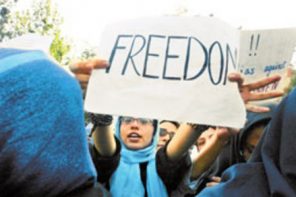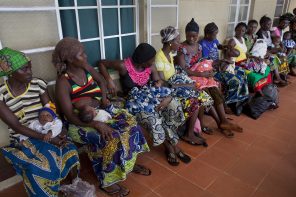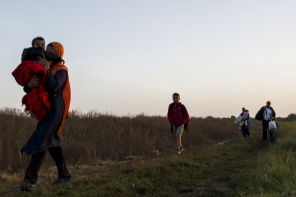This week, the American Congress finally resolved its squabbles and brought itself to reauthorize the Violence Against Women Act. It was a fight, as many others will tell you.
But there’s another battle still to fight, and that’s how we talk about violence against women.
On Thursday, TIME magazine published a photo essay by Sara Naomi Lewkowicz. The essay began as a project about a woman named Maggie and her boyfriend, Shane. One night, an argument escalated to physical assault as the photographer was taking pictures.
The internet went crazy, blaming Sara for not trying to stop the violence — even though she called 911. Even though her presence probably kept Maggie safer than she might otherwise be, based on what Shane was screaming as he beat her. Even though the police are using Sara’s images to prosecute Shane.
At Salon, I write a seemingly deep collective need to blame everyone but the abuser for the abuse that happened that night. Here’s a sample:
Many of us are familiar with the phrase “blame the victim,” and there’s no shortage of that in the comments, at Time, on Sara’s essay. Here’s a sampling of the ideas you’ll find there: Maggie, the beaten girlfriend, should have seen this coming. Maggie stays because she likes it. Good riddance, Maggie was cheating on her then-estranged husband anyway … etc. In classic form, one insists of Maggie, “She is not the victim. She is the perpetrator.”
If there’s a single thing about which the critics shouting about Maggie and Sara in Time’s comment section seem to agree, it’s this: The only adult in the house during the assault who isn’t responsible for the violence is the man committing it.
And at the Atlantic, I ask why on earth the cover story in the latest TIME magazine, about the trial of South African sports hero Oscar Pistorius for the fatal shooting of his girlfriend, talks about everything — race, class, wealth, inequality, sports, iconography, the Truth and Reconciliation Commission — except domestic violence.
[TIME] says that you can’t understand the Pistorius shooting — Pistorius denies murder — if you don’t understand Cape Town. And class. And wealth disparity. And race. And sports. And — of course — Apartheid.All of these things combine in Perry’s story to explain a privileged white man’s fear of an imagined assailant which, according to his defense, led him to shoot his privileged white girlfriend. The only thing that doesn’t seem to merit inquiry in this American banner publication — ironically, published within 24 hours of the reauthorization of the Violence Against Women Act — is domestic violence.
You’d have thought I’d have exhausted myself, but one thing I’m still thinking about: When is domestic violence treated, and tracked, as a criminal issue, and when it’s treated, and tracked, as a public health issue, and what differences might that make?
Weigh in, world.




It strikes me that photos of domestic violence are less common, and perhaps therefore more contentious, than photos of violent conflict. Do people ever raise the same objection to journalists working in conflict zones that they raised to Lewkowicz – that they should be *doing something* about the violence they see rather than just idly snapping photos? There are obvious questions of scale – it’s easier to imagine intervening in a fight between a couple than between two armed groups – but I wonder what this says about our cultural expectations of different types of violence. We seem to expect female survivors of domestic violence to have an awful lot of agency – that they should change their behavior, refrain from provocation, leave their own homes, etc. in order to avoid abuse – while civilians affected by conflict are often portrayed as helpless victims, with no ability to control the violence around them.
Good questions, Rachel. Yes, I understand from colleagues this is a pretty common criticism of photographers. There was an article in a journalism magazine in 1999 that called this “the age old question.” One can argue, often with accuracy and facts in hand, that journalistic witnessing makes a real difference. In the case of this essay, the photographer called 911, and the abuser made it clear his behavior was restrained because of the presence of the camera. Not just another person — there were two friends of his in the house — but the camera (he told his girlfriend they should go to the basement and finish the dispute because “it’s not of her fucking business,” pointing at the photog).
The conflict question is interesting: The Save Darfur movement and offshoots popularized the idea that witnessing without acting is bystanding. So what to make of journalists taking pictures, or writing about, civilians? Does the logic hold?
Not conflict, but another example: You probably know Kevin Carter’s famous picture of the Sudanese child with the vulture in the background. He was heavily criticized for not doing something. Three months after he won the Pulitzer Prize for the photo, he killed himself.
Yes! I have a piece up on the Guardian about VAW now and the comments have been overwhelmingly from people trying to “convince” me that more men experience violence and that that somehow renders the conversation about VAW pointless or something. It’s kind of mind numbing actually. There is this incredible resistance to talking about VAW from almost any vantage point, or this desire to explain it away with cultural contexts and root causes. It is so important to understand an act of violence in a context, BUT the perpetrator is still the accountable actor and the only real accountable actor. I think there is an overwhelming push from victims’ rights advocates and women’s groups who work on violence to see more attention paid to perps — research into why men perp violence, programs to address their actions (whether it is jail or rehab, etc.) and a shift of the cultural eye away from victims and toward perps, with regards to blaming… There is a major conversation that needs to happen that isn’t happening.
So many important points there, Jess. I hope those conversations start.
Apropos comments, here’s an interesting piece, at Salon, about how comments skew readers’ interpretation of stories. With that in mind, I feel bolstered to ignore comments on news sites and stick with reading comments on blogs I know and like, where a real conversation develops. Which is what I do anyway, it’s just nice to feel vindicated.